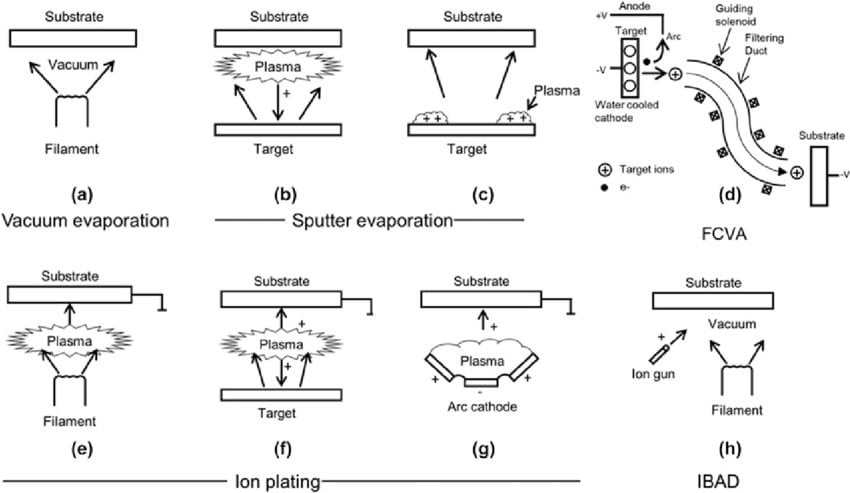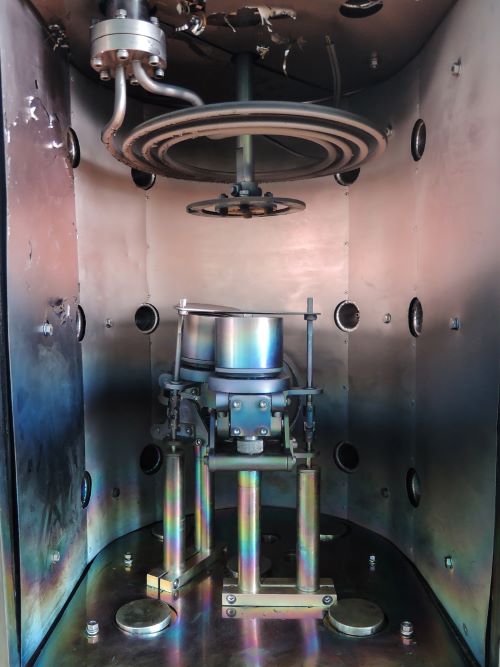There are various vacuum processes used to create thin film deposition (coatings) of metal, alloys and non-metals. This can be achieved through mechanical, electromechanical or thermodynamic means. Kamet’s mineral insulated vacuum heaters have a broad range of application in deposition systems.
What is Physical Vapour Deposition (PVD)?
In physical vapour deposition (PVD), metals and alloys are evaporated from a source and the atoms, ions or molecules are deposited onto the substrate surface using thermal evaporation, sputtering or electron beam (e-beam). The choice of technique depends on the specific type of material being deposited.
Magnetron sputtering
- Uses an electrically generated plasma between the source and the (heated) substrate (usually glass).
- Suitable for:
- clear conductive metal oxides: InSnO or ITO is often used
- metals with a high melting point such as Au, Pt, Ti, Cr
E-Beam evaporation
- A magnet accelerates electrons in an intense beam used to heat up the material for evaporation.
- Achieves dense coatings of high purity on the (heated) substrate.
- Used for deposition of materials that cannot be achieved using standard thermal evaporation due to low thermal conductivity.
Thermal evaporation
- Most common and simple form of deposition
- Requires high vacuum deposition conditions (10E-5 mbar and higher)
- A resistive heating element brings the source material in a resistive boat to its boiling point
- Vaporized molecules form a thin-film deposition (coating) on the substrate.
- Can be used for almost any inorganic as well as some organic coatings on a wide variety of substrates
- More environmentally friendly
- Allows high purity deposition from high-purity source material (very little contamination due to the high vacuum).
What heating solutions does Kamet offer for PVD?
Kamet wafer heaters are an important component in magnetron sputtering. We are also able to customize our substrate heaters (otherwise known as chuck heaters or sample heaters) to meet specific process requirements. For example, casting a mineral insulated heating element in the heating chuck for PVD surfaces. Microheaters are an other custom designed small heating solution for PVD.
In fact, Kamet’s strength lies in offering extremely accurate, customized solutions tailored to our clients specific high-end needs in the semiconductor industry. For such projects we also work closely with the specialists at our partner company, ARi who supply our MI heaters.
What are the advantages of using mineral insulated heating elements for PVD?
- Temperatures of up to 1000°C
- Mineral insulation ensures the heating elements are suited
- to demanding atmospheres (vacuum, inert gases)
- chemical resistance
- excellent dielectric endurance
- Custom sheath materials are available to match any environment
- Seamless transitions between the hot and cold sections of heaters
- The hot and cold sections have equal diameters
- Termination is simple due to cold ends which prevents overheating
- Suited to high power density
- Uniformity of heat distribution to a source, wafer, target or substrate
- A large bending radius makes heating elements suited to intricate, curved applications
- Precise heating for critical processes
- Thinner, low mass designs are possible.
- Fast warming up times
- Sealed heating elements prevent contamination
- Thermocouples can be included in the design
More about our work for the semiconconductor industry you can read here. If you have any questions or like to talk to us about your application. You can contact us via this form.

